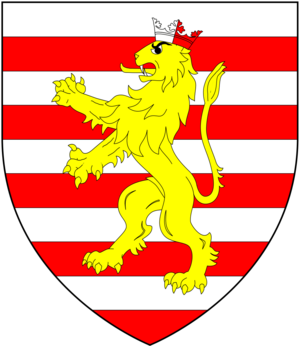William Brandon (died 1491) facts for kids
Sir William Brandon (who died in 1491) was an important English person from Wangford, Suffolk. He owned land, helped manage the government, was a soldier, worked for the king, and was involved in politics. His grandson, Charles Brandon, became the 1st Duke of Suffolk and was a close friend of King Henry VIII.
Contents
Early Life and Family Roots
William Brandon was born before 1430. His father was likely Robert Brandon, who collected taxes on goods coming into King's Lynn and Great Yarmouth in Norfolk. Robert also served as a Member of Parliament for Bishop's Lynn in 1421.
Sir William's Career and Public Service
William Brandon became a trusted helper for powerful local families, especially the Dukes of Norfolk. By 1476, he was a senior member of the council for John de Mowbray, the 4th Duke of Norfolk.
From 1454 to 1455, he worked as an escheator for Norfolk and Suffolk. An escheator was an officer who made sure the king got back land when someone died without an heir. In 1468, he was a Member of Parliament for New Shoreham.
Military Service and Royal Connections
In 1469, Sir William was part of the Siege of Caister Castle. This was a famous battle where the Duke of Norfolk's forces attacked the castle.
In 1471, he fought with the Yorkist army, who won the Battle of Tewkesbury. After this victory, King Edward IV knighted him on the battlefield. Being knighted meant he was a respected soldier and gentleman. Later that year, he was one of ten knights who promised loyalty to the Prince of Wales, who would later become King Edward V.
In 1475, he went to France as a soldier during an invasion. This war ended with a peace agreement called the Treaty of Picquigny.
Working for the King
As someone who worked closely with the Royal Household, Sir William was given an important job in 1479. He became the Knight Marshal of the Marshalsea Court. This was a job for life, and it involved keeping order in the king's court and managing prisoners. His son, Thomas, took over this job in 1491.
In July 1483, Sir William was at the coronation of King Richard III. Even though the king seemed to favor him, his loyalty was questioned. This happened when two of his sons, William and Thomas, joined a rebellion in October 1483. Some of his lands were taken by the king's orders. However, he received a full pardon in March 1484, meaning he was forgiven.
By the end of 1484, he was out of favor with the king again. He sought safety in Gloucester, where he stayed until King Richard III was defeated and died at the Battle of Bosworth in August 1485. After this, he asked Parliament to get his job as Knight Marshal back, and he succeeded.
Family Life and Children
Before January 1462, Sir William married Elizabeth Wingfield. She was the daughter of Sir Robert Wingfield. Elizabeth lived longer than William, and they had three sons and seven daughters:
- Sir William Brandon: He was the oldest son and inherited his father's lands. He married Elizabeth Bruyn. One of their sons was Charles Brandon, who became the 1st Duke of Suffolk and a close friend of King Henry VIII.
- Sir Thomas Brandon: He married twice. His first wife was Anne Fiennes, and his second was Elizabeth Dinham.
- Sir Robert Brandon: He married Catharine la Zouche.
- Mary Brandon: She worked for Prince Henry, who later became King Henry VIII. She married John Reading, who was King Henry VII's treasurer.
- Anne Brandon: She married Nicholas Sidney and was the mother of Sir William Sidney.
- Elizabeth Brandon: She married Augustine Cavendish and later John Leventhorpe.
- Margaret Brandon "The Elder": She married Sir Gregory Lovell.
- Margaret Brandon "The Younger": She married Hugh Manning.
- Catherine Brandon: She married John Gurney.
- Eleanor Brandon: She married John Glemham.
Land and Property
Sir William owned lands in several places. In Suffolk, he had land at Framlingham, Henham, and Wangford. He also held land in Soham, Cambridgeshire. In Southwark, near London, he had a home on Borough High Street. This street was close to the River Thames and a main road from London Bridge to Canterbury. Today, Suffolk Street in that area is named after his grandson, the Duke of Suffolk.
Death and Burial
Sir William Brandon made his will on April 9, 1491. He asked to be buried in Wangford. His will was officially approved on November 17, 1491.


